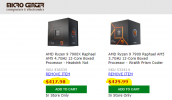I really haven't kept up on tech in great detail the last couple years, but this sounds pretty good.
I'm not sure how I feel about this though.
My initial thought is I doubt DDR5 is going to benefit crunching, at least in a meaningful way, and almost certainly not enough to justify the cost. I guess it will be one of those pay to play situations.
The biggest news for the 5nm Zen 4 chips comes as a 15% or better improvement in single-threaded performance over the previous-gen Zen 3-powered Ryzen 5000 processors. AMD tells us that this comes as a mixture of instruction per cycle (IPC) and frequency improvements, but won't share the specific percentage each factor contributes until later. AMD says the chips will reach 'significantly above' a 5 GHz peak frequency and even demoed a 16-core model hitting 5.5 GHz. However, that comes with the standard caveat that this frequency only applies to a single core during a light bursty workload, just as we've seen with Zen 2 and Zen 3 processors.
That means the 15%+ figure isn't based solely on IPC improvements, but improved single-thread performance does boost performance across the board as it is amplified as workloads spread across the cores. To that effect, AMD also boosted the maximum power delivery of the AM5 socket (PPT) that will house the Ryzen 7000 chips to 170W, a 28W increase over the previous-gen AM4 socket's 142W peak. If AMD sticks to its standard use of PPT x 1.35x = TDP, that means we'll see AM5 socket chips top out at a 125W TDP. We'll dive into performance comparisons a bit further below, but it looks like we'll see a closer-than-expected race between Ryzen 7000 and Intel's Alder and Raptor Lake chips.
I'm not sure how I feel about this though.
Finally, AMD has confirmed that the AM5 socket will only support DDR5 memory. The company says that DDR5 provides the extra performance to justify the cost, but we'll have to watch pricing closely. As we've reported, DDR5 pricing remains prohibitively expensive, but Micron expects PMIC/VRM supply to rebound in the second half of 2022, so we could see the situation improve as AMD's Zen 4 Ryzen 7000 processors come to market.
However, DDR5's more complex power circuitry and design mean that these modules will continue to command a premium over DDR4. DDR5 also has in-built ECC mechanisms for data at rest, which requires additional dies to provide the same memory capacity as DDR4. Though the pricing differences will become smaller over time, DDR5 will remain more expensive than DDR4, regardless of supply. We'll have to wait until closer to the launch to see how this impacts Ryzen 7000's platform costs.
My initial thought is I doubt DDR5 is going to benefit crunching, at least in a meaningful way, and almost certainly not enough to justify the cost. I guess it will be one of those pay to play situations.




